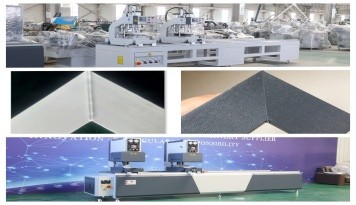In PVC door and window manufacturing, welding machines are pivotal for fusing profiles into integral structures. Ordinary and seamless PVC welding machines cater to distinct market demands, differing vastly in functionality, performance, and application value. Below is a detailed overview of their features and advantages.
Ordinary PVC Door & Window Welding Machines
Ordinary welding machines are entry-level equipment optimized for basic PVC profile fusion. Their core working principle involves heating PVC profiles to a molten state (around 200-230℃) via heating plates, then applying pressure to bond them.
Their primary advantages lie in cost efficiency and operational simplicity. With a relatively low purchase cost and minimal auxiliary equipment requirements, they are ideal for small workshops, startups, or manufacturers focused on budget-friendly PVC products. Operationally, they feature straightforward control panels—operators only need basic training to master temperature and pressure settings, reducing labor costs. Maintenance is also hassle-free, as their structural design is simple, with fewer easily worn parts and low repair expenses. Additionally, they offer versatility in basic applications, adapting to standard PVC profiles (e.g., casement, sliding window frames) commonly used in residential buildings.
However, their limitations are notable: welded joints are clearly visible, lacking aesthetic refinement; precision is modest (typically ±0.3-0.5mm), which may affect long-term structural stability; and sealing performance is average, as seams can potentially leak air or water over time.
Seamless welding machines represent high-end equipment tailored for premium PVC door and window production, integrating welding, shaping, and post-polishing functions. Beyond the basic heating-pressure fusion process, they add a critical milling and polishing step—after welding, a high-speed cutter trims excess material, and abrasive tools smooth the joint until it is nearly indistinguishable from the original profile.
Their standout advantages include superior aesthetics. The seamless joints eliminate visual gaps, giving products a sleek, monolithic appearance that meets the demands of high-end real estate, luxury homes, and commercial projects. Secondly, enhanced sealing and durability are achieved: seamless joints prevent water infiltration and air leakage, improving thermal insulation and extending the product’s service life. They also boast exceptional precision (up to ±0.1mm), ensuring tight profile fitting and consistent quality. Moreover, they can handle complex profiles (e.g., curved frames or multi-cavity structures), expanding design possibilities for manufacturers. The main tradeoff is higher upfront investment, including the machine itself and specialized polishing tools. They also require skilled operators to manage precise parameter adjustments and polishing techniques.
In conclusion, ordinary PVC welding machines excel in cost and simplicity for basic production, while seamless models deliver premium aesthetics and performance for high-end markets. Manufacturers choose based on their target customer segments, production scale, and product quality.






